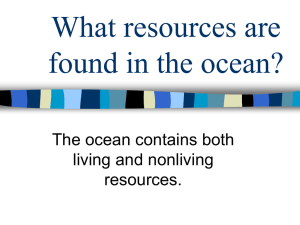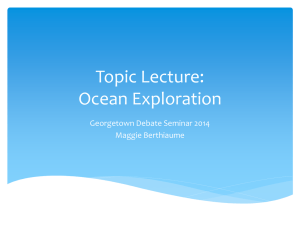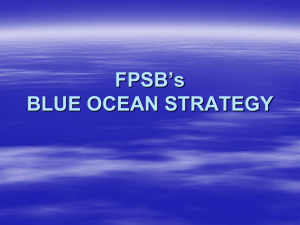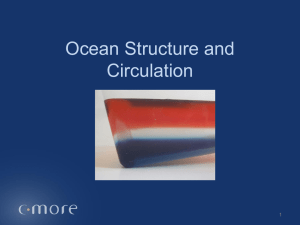oceanic - Southern Local Schools
advertisement
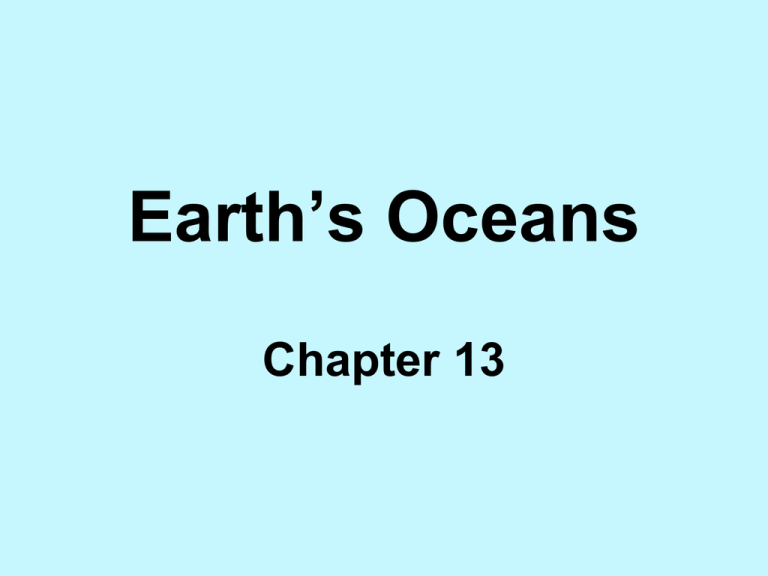
Earth’s Oceans Chapter 13 • In your science log, try to answer the following questions based on what you already know: 1) How have Earth’s oceans changed over time? 2) Name two ways scientists study the ocean without going underwater. 3) Name two valuable resources that are taken from the ocean Earth’s Oceans • Earth stands out from the other planets in our solar system primarily for one reason – 71 percent of the Earth’s surface is covered with water. Most of the Earth’s water is found in the global ocean, which is divided by the continents into four main oceans. How Did the Oceans Form? • About four and a half billion years ago, the Earth was a very different place. There were no oceans. Volcanoes spewed lava, ash, and gases all over the planet, which was much hotter than it is today. The volcanic gases, including water vapor, began to form the Earth’s atmosphere. While the atmosphere developed, the Earth was cooling. Sometime before 4 billion years ago, the Earth cooled enough for water vapor to condense and fall as rain. The rain began filling the lower levels of Earth’s surface, and the first oceans began to form. IS THAT A FACT!!! • The global ocean covers nearly 376 million square kilometers. The entire North American continent, by comparison, covers only a little more than 24 million square kilometers. SCIENTISTS AT ODDS • When Earth cooled about 4 billion years ago, the rains that resulted lasted for thousands of years. But some scientists do not believe all the water on Earth came from condensation as Earth cooled. Instead, they argue that some of the water came from “cosmic rain” – comets that struck Earth in its early history. Mnemonics • Create a mnemonic device that will help you remember the names of the world’s oceans. For example, you might write, Aunt Patty Ate Inchworms in order to recall Atlantic, Pacific, Artic and Indian. Share your ideas with the class. CONNECTION • Condensation is a physical change from a gas to a liquid. In the atmosphere, the amount of water vapor that the air can hold is dependent on temperature. As temperature decreases, the air can hold less water vapor, and the water vapor condenses, forming clouds. Characteristics of Ocean Water • You know that ocean water is different from the water that flows from the faucet of your kitchen sink. For one thing, Ocean water is not safe to drink. But, there are other characteristics that make ocean water special. Ocean Water is Salty • Have you ever swallowed a mouthful of water while swimming in the ocean? Most of the salt in the ocean is the same kind of salt that we sprinkle on our food. Scientists call this salt sodium chloride. • The most abundant dissolved solid in the ocean is sodium chloride, a compound of the elements sodium (Na) and chlorine (CI). Chock-full of Solids • If more water evaporates than enters the ocean, the ocean’s salinity increases. Salinity is a measure of the amount of dissolved salts and other solids in a given amount of liquid. Think of it this way: 1 kg (1,000 g) of ocean water contains 35 g of dissolved solids on average. Therefore, if you evaporated 1 kg of ocean water, about 35 g of solids would remain. Factors That Affect Salinity • Some areas of the ocean are saltier than others. Coastal water in areas with hotter, drier climates typically have a higher salinity than coastal water in cooler, more humid areas. Another factor that affects ocean salinity is water movement. Surface water in some areas of the ocean, such as bays, gulfs, and seas, circulates less than surface water in other parts. Science Humor • Question: Why is the ocean salty? •Answer: Because fish don’t like pepper Temperature Zones • The temperature of ocean water decreases as the depth of the water increases. Water in the ocean can be divided into three layers according to temperature. Surface zone • The surface zone is the warm, top layer of ocean water that extends to 300 m below sea level. Sunlight heats the top 100 m of the surface zone. Surface currents mix the heated water with cooler water below. Thermocline • The thermocline is a layer of water extending from 300 m below sea level to about 800 m below sea level. In this zone, water temperature drops with increased depth faster than it does on the other two zones. Deep zone • This bottom layer extends from the base of the thermocline to the bottom of the ocean. The temperature in this zone averages a chilling 2 degree C. IS THAT A FACT!! • The deepest water in the ocean is colder than 00 C, but it remains liquid because of its salinity and the increased pressure at that depth. WEIRD SCIENCE • The Amazon River feeds so much fresh water into the Atlantic Ocean that the ocean water has different salinity and color almost 160 km from shore! Surface Temperature Changes • Temperatures in the surface zone vary with latitude and the time of year. Surface temperatures range from 10 C near the poles to about 240 C near the equator. Areas of the ocean along the equator are warmer because they receive more sunlight per year than areas closer to the poles. The Ocean and the Water Cycle • If you could sit on the moon and look down at Earth, what would you see? You would notice that Earth’s surface is made up of three basic components – water, land, and air. All three are involved in an ongoing process called the water cycle. The water cycle is a cycle that links all of Earth’s solids, liquid, and gaseous water together. The ocean is an important part of the water cycle because nearly all of Earth’s water is found in the ocean. IS THAT A FACT!! • Twelve thousand years ago much of Earth’s water was frozen in glaciers and icecaps, and the Atlantic coast was miles farther out than it is today. Modern-day divers exploring the Chesapeake Bay found a mound of oyster shells – the remains of a longago picnic – 40 m below sea level! QUIZ 1. How is the global ocean divided, and what are the divisions? 2. How do scientists think the oceans are likely to change in the future? 1. It is divided by the continents into four main oceans, the Pacific, the Atlantic, the Indian, and the Artic. 2. They predict that the oceans will change in size and shape as the continents move apart. A Global Thermostat • The ocean plays a vital role in maintaining conditions favorable for life on Earth. Perhaps the most important function of the ocean is to absorb and hold energy from sunlight. This function regulates temperatures in the atmosphere. A Hot Exchange • The ocean absorbs and releases thermal energy much more slowly than dry land does. If it were not for this function of the ocean, the average air temperature on Earth would vary from above 1000 C during the day to below –1000 C at night. This rapid exchange of energy between the atmosphere and the Earth’s surface would cause violent weather patterns. Life as we know it could not exist with these unstable conditions. Have Heat, Will Travel • The ocean also regulates temperatures on a more local scale. At the equator, the sun’s rays are more direct, which causes equatorial waters to be warmer than the waters at higher latitudes. But, currents in the oceans circulate water, as well as the energy it contains. The circulation of warm water causes some coastal lands to have warmer climates than they would have without the currents. The British Isles, for example, have a warmer climate than most regions at the same latitude because of the warm water of the Gulf Stream. The Ocean Floor • What lies at the bottom of the ocean? How deep is the ocean? These are questions that were once unanswerable. But humans have learned a lot about the ocean floor, especially in the last few decades. Using state-of-the-art technology, scientists have discovered a wide variety of landforms on the ocean floor. Scientists have also determined accurate depths for almost the entire ocean floor. MATH and MORE • Water pressure increases with depth. For every 10 m of depth, the pressure increases by 1 atmosphere (atm). For example, at a depth of 10 m, the pressure is 2 atm, or twice the pressure of the atmosphere at sea level. • What is the pressure at 20 m? • What is the pressure at 50 m? • What is the pressure at 100 m? • What is the pressure at the bottom of the Mariana Trench? ANSWERS • • • • 3 atm 6 atm 11 atm Greater than 1200 atm Revealing the Ocean Floor • If you could travel to the bottom of the ocean in Deep Flight, you would see the word’s largest mountain chain and canyons deeper than the Grand Canyon. And because it is under water, much of this area is unexplored. Ocean Floor contd. • As you began your descent into the underwater realm, you would notice two major regions – the continental margin, which is made of continental crust, and the deep-ocean basin, which is made of oceanic crust. It may help to imagine the ocean as a giant swimming pool; the continental margin is the shallow end and slope of the pool, and the deep-ocean basin is the deep end of the pool. Underwater Real Estate • As you can see, the continental margin is subdivided into the continental shelf, the continental slope, and the continental rise based on depth and changes in slope. The deepocean basin consists of the abyssal plain, with features such as mid-ocean ridges, rift valleys, and ocean trenches that form near the boundaries of Earth’s tectonic plates. On part of the abyssal plain that are not near plate boundaries, thousands of seamounts are found on the ocean floor. SCIENCE HUMOR • Question: What lies on the bottom of the ocean and trembles? •Answer: a nervous wreck Viewing the Ocean Floor from Above • In spite of the great success of underwater exploration, sending scientists into deep water is still risky. Fortunately, there are ways to survey the underwater realm from the surface and from high above in space. Oceanography via Satellite • In the 1970’s, scientists began to studying Earth from satellites in orbit around the Earth. In 1978, scientists launched the satellite Seasat. This satellite focused on the ocean, sending images back to Earth that allowed scientists to measure the direction and speed of ocean currents. Contd. • Geosat, once a top-secret military satellite, has been used to measure slight changes in the height of the ocean’s surface. Different underwater features, such as mountains and trenches, affect the height of the water above them, thus reflecting the underwater topography of the ocean floor. BRAIN FOOD • You may be surprised to learn that underwater features such as seamounts and trenches affect the height of the ocean above them. Interestingly, the topography and composition of the ocean floor causes differences in the gravity that are pronounced enough to affect sea level. For example, the mass of a seamount creates enough gravitational attraction to cause a 5 m bulge of water above it. Similarly, the sea level above a deep-sea trench can be depressed by as much as 60 m! QUIZ 1. Which features of the abyssal plain form at the boundaries of tectonic plates? 2. How is the depth of the ocean measured? 1)mid-ocean ridges, rift valleys, ocean trenches 2)It is measured using sonar. Scientists calculate the depth by multiplying half the time it takes a sound wave to hit the ocean floor and return to the surface by the speed of sound in water. Life in the Ocean • The ocean contains a wide variety of life forms, many of which we know little about. Trying to study them can be quite a challenge for scientists. To make things easier, scientists classify marine organisms into three main groups. Scientists also divide the ocean into two main environments based on the types of organisms that live in them. These two main environments are further subdivided into ecological zones based on locations of different organisms. The Three Groups of Marine Life • The three main groups of marine life are plankton, nekton, and benthos. Marine organisms are placed into one of these three groups according to where they live and how they move. Plankton • Are organisms that float at or near the ocean’s surface. Most plankton are microscopic. Plankton are subdivided into two groups – those that are plantlike (phytoplankton) and those that are animal-like (zooplankton). Nekton • Are the free-swimming organisms of the ocean. Types of nekton include mammals, such as whales, dolphins, and sea lions, as well as many varieties of fish. Nekton are most abundant in surface water. Benthos • Are organisms that live on or in the ocean floor. They live in mud, sand, and rock. There are many types of benthos, such as crabs, sea stars, worms, coral, sponges, seaweed, and clams. The Benthic Environment • The benthic environment, or bottom environment, is the ocean floor and all the organisms that live on or in it. Intertidal Zone • The shallowest benthic zone, the intertidal zone, is located between the low-tide and high-tide limits. Twice a day, the intertidal zone transforms. As the tide flows in, the zone is covered with ocean water, and as the tide retreats, the intertidal zone is exposed to the air and sun. Intertidal Zone contd. • Intertidal organisms must be able to live both underwater and on exposed land. Some organisms attach themselves to rocks and reefs to avoid being washed out to sea during low tide. Some animals can burrow in the sand or between rocks. Plants such as seaweed have strong holdfasts (root like structures) that allow them to grow in this zone. Sublittoral Zone • The Sublittoral zone begins where the intertidal zone ends, at the low-tide limit, and extends to the edge of the continental shelf. This benthic zone is more stable than the intertidal zone; the temperature, water pressure, and amount of sunlight remain fairly constant. Sublittoral organisms, such as coral, do not have to cope with as much change as intertidal organisms. Although the sublittoral zone extends down 200 m below sea level, plants and most animals stay in the upper 100 m, where the sunlight reaches the ocean floor. MNEMONICS • Create a mnemonic device that will remind you of the zones of the benthic environment. For example, they might write Isabel Sent Bart Away from Home to remind them that the zones are Intertidal, Sublittoral, Bathyal, Abyssal, and Hadal. Share your mnemonic devices with the rest of the class. MISCONCEPTION ALERT • Many people think that rain forests produce most of Earth’s oxygen. Actually, ocean phytoplankton are the most productive photosynthesis on the planet. Because phytoplankton consume the greenhouse gas CO2 during photosynthesis, many scientists think that phytoplankton populations play a significant role in global climate patterns. Bathyal Zone • The Bathyal Zone extends from the edge of the continental shelf to the abyssal plain. The depth of this zone ranges from 200 m to 4, 000 m below sea level. Because of the lack of sunlight at these depths, plant life is scarce in this part of the benthic environment. Animals in this zone include sponges, brachiopods, sea stars, echinoids, and octopus. Abyssal Zone • No plants and very few animals live in the abyssal zone, which is on the abyssal plain. Among the abyssal animal types, are crabs, sponges, worms, and sea cucumbers. Many of these organisms live around hot-water vents called black smokers. The abyssal zone can reach 6,000 m in depth. Hadal Zone • The deepest benthic zone is the hadal zone. This zone consists of the floor of the ocean trenches and many organisms found there. So far, scientists have discovered a type of sponge, a few species of worms, and a type of clam. THE PELAGIC ENVIRONMENT • The pelagic environment is the entire volume of water in the ocean and the marine organisms that live above the ocean floor. There are two major zones of pelagic environment – the neritic zone and the oceanic zone. Neritic Zone • The neritic zone includes the volume of water that covers the continental shelf. This warm, shallow zone contains the largest concentration of marine life. This is due to an abundance of sunlight and to the many benthos below the neritic zone that serve as a food supply. Fish, plankton, and marine mammals, are just a few of the animal groups found here. Oceanic Zone • The oceanic zone includes the volume of water that covers the entire sea floor except for the continental shelf. In the deeper parts of the oceanic zone, the water temperature is colder and the pressure is much greater than in the neritic zone. Also, organisms are more spread out in the oceanic zone. QUIZ 1. Why do scientists know little about the abyssal and hadal zones? 2. Where do most of marine organisms live? 1.Because these zones are so deep and dark, scientists know very little about them. 2.In the neritic zone RESOURCES FROM THE OCEAN • The ocean offers a seemingly endless supply of resources. Food, raw material, energy, and drinkable water are all harvested from the ocean. And there are probably undiscovered resources in unexplored regions of the ocean. As human populations have grown, however, the demand for these resources has increased while the availability has decreased. Living Resources • People have been harvesting marine plants and animals for food for thousands of years. Many civilizations formed in coastal regions that were rich enough in marine life to support growing human populations. Fishing the Ocean • Harvesting food from the ocean is a multi-billion-dollar industry. Of all the seafood taken from the ocean, fish are the most abundant. Almost 75 million tons of fish are harvested each year. With improved technology, such as sonar and drift nets, fisherman have become better at locating and taking fish from the ocean. Farming the Ocean • As over fishing reduces fish populations and laws regulating fishing become stricter, it is becoming more difficult to supply our demand for fish. To compensate for this, many ocean fish, such as salmon and turbot, are being captively bred in fish farms. Fish farming requires several holding ponds, each containing fish at a certain level of development. Savory Seaweed • Fish are not only the seafood harvested in a farm like setting. Shrimp, oysters, crabs, and mussels are raised in enclosed areas near the shore. Mussels and oysters are grown attached to ropes. Savory Seaweed • Many species of algae, commonly known as seaweed, are harvested from the ocean. For example, kelp, a seaweed that grows as much as 33 cm a day, is harvested and used as a thickener in jellies, ice cream, and similar products. The next time you enjoy your favorite ice cream, remember that without seaweed, it would be a runny mess. BRAIN FOOD • Did you know that the United States imports more oil than any other nation? Because oil is a nonrenewable resource, scientists continue to research alternative to fossil fuels, such as solar energy and wind-generated electricity. IS THAT A FACT!! • Much of the world’s petroleum deposits formed millions of years ago when dead organisms accumulated on the ocean floor. Crushed and buried deep beneath the surface by the overlying sediment, this organic matter eventually turned into oil or natural gas Fresh Water and Desalination • In some areas of the world where fresh water is limited, people desalinate ocean water. Desalination is the process of evaporating sea water so that the water and the salt separate. But desalination is not as simple as it sounds, and is very costly. Saudi Arabia, is located in the desert region of the Middle East, has one of the largest desalination plants in the world. Sea-Floor Minerals • Mining companies are very interested in mineral nodules that are lying on the ocean floor. These nodules are made mostly of manganese, which can be used to make certain types of steel. They also contain iron, copper, nickel, and cobalt. Other nodules are made of phosphates, which are used in making fertilizer. Sea-Floor Minerals • Nodules are formed from dissolved substances in sea water that stick to solid objects, such as pebbles. As more substances stick to the coated pebble, a nodule begins to grow. Manganese nodules range from the size of a marble to the size of a soccer ball. WEIRD SCIENCE • Buried in sea floor sediments at depths greater than 500 m below sea level, an ice called, methane hydrate may be twice as abundant as all other fossil fuels combined. Methane hydrate has also been discovered in the permafrost of Siberia and Alaska. Clean burning and abundant methane hydrate could be the fuel of the future, but engineers have not yet discovered an efficient way to mine it. Tidal Energy • The ocean creates several types of energy resources simply because of its constant movement. The gravitational pull of the sun and moon causes the ocean to rise and fall as tides. Tidal energy, energy generated from the movement of tides, is an excellent alternative source of energy. If the water during high tide can be rushed through a narrow coastal passageway, the water’s force can be powerful enough to generate electricity. Tidal energy is a clean, inexpensive, and renewable resource once the dam is built. A renewable resource can be replenished, in time, after being used. Unfortunately, tidal energy is practical only in a few areas of the world. Wave Energy • Have you ever stood on the beach and watched as waves crashed onto the shore? This constant motion is an energy resource. Wave energy, like tidal energy, is a clean, renewable resource QUIZ 1. Explain some of the ecological risks of using drift nets? 2. What are nonrenewable resources? Give two examples. 3. What is desalination, and why is it done? 1. Using drift nets can lead to over fishing, which depletes fish population. Drift nets also accidentally trap other marine animals such as dolphins and turtles. 2. Nonrenewable resources are resources that are used up faster than they can be replenished naturally. Natural gas and oil are nonrenewable resources. 3. Desalination is the process of evaporating sea water so that the water and salt separate. Desalination provides fresh water for human use. Ocean Pollution • Humans have used the ocean for waste disposal for hundreds of years, if not thousands, of years. This has harmed the organisms that live in the ocean as well as animals that depend on marine organisms. People are also affected by polluted oceans. Fortunately, we are becoming more aware of ocean pollution, and we are learning from our mistakes. Sources of Ocean Pollution • There are many sources of ocean pollution. Some of these sources are easily identified, but others are more difficult to pinpoint. Trash Dumping • People dump trash in many places, including the ocean. The Environmental Protection Agency (EPA) began an investigation and discovered that hospitals in the United States produce an average of 3 million tons of medical waste each year. And where does some of this trash end up? You guessed it – in the ocean. SCIENCE HUMOR • Huntsville, Alabama hairdresser Phil McCrory has patented a way to use discarded human hair to clean up oil spills. He tested the idea in his son’s wading pool using a pair of pantyhose filled with hair. The idea works so well that McCrory has attracted attention of NASA Environment CONNECTION • In Austin, Texas, sludge is used to make compost called Dillo Dirt. (Dillo refers to armidillo, a small aardvark-like mammal common in Texas). Instead of polluting the Gulf of Mexico, Austinites are using sludge to grow beautiful and beneficial gardens. Sludge Dumping • BY 1990, the United States alone had discharged 38 trillion liters of treated sludge into the waters along its coasts. What is sludge, and why is it so bad? To answer this question, we need to define raw sewage. • Raw sewage is all the liquid and solid waste that are flushed down toilets and poured down the drains. After collecting in sewer drains, raw sewage is sent through a treatment plant, where it undergoes a cleaning process that removes the solid waste. The solid waste is called sludge. In many areas, people dump sludge into the ocean several kilometers offshore, intending for it to settle to and stay on the ocean floor. Many countries have banned sludge dumping, but it continues to occur in many areas of the world. Non-point Source Pollution • We usually think of water pollution as coming from large factories, but you may be surprised to know that most of the pollution comes from everyday citizens doing everyday things. This type of pollution is called non-point source pollution, because you cannot pinpoint the exact source. IS THAT A FACT! • The world’s first major oil spill occurred on March 18, 1967. The tanker Torrey Canyon ran aground off the coast near Cornwall, England. The ship spilled about 870,000 barrels of oil, more than three times the oil spilled by the Exxon Valdez. Oil Spills • Because oil is in such high demand across the world, large tankers must transport billions of barrels of it across the oceans. If not handled properly, these transports can quickly turn disastrous. In 1989, the supertanker Exxon Valdez struck a reef and spilled more than 260,000 barrels of crude oil. The effect of this accident on wildlife was catastrophic. Many animals died. Alaskans who made their living from fishing, lost their businesses. Today many oil companies are using new technology to safeguard against oil spills. Tankers are now being built with two hulls instead of one. BRAIN FOOD • Within the first few weeks of the Exxon Valdez oil spill, more than a half million birds, including 109 endangered bald eagles, were covered in oil and drowned. Almost half the sea otters in the area also died either from drowning or from being poisoned by the oil. CONNECT TO ENVIRONMENTAL SCIENCE • The Oil Pollution Act of 1990 was a direct response of the Exxon Valdez oil spill. The controversial bill had been debated for 14 years; it passed swiftly in the aftermath of the disaster. Under the law, all oil tankers operating in United States waters must be double-hulled by 2015. Compliance had been slow, however; many oil companies have been reluctant to replace the aging boats in their fleet with hundred-milliondollar, double-hulled ships. As of 1999, of the 3,294 oil tankers operating worldwide, only 876 were double-hulled. Saving Our Ocean Resources • Although humans have done much to harm the oceans resources, we have also begun to do more to save them. From international treaties to volunteer cleanups, efforts to conserve the ocean’s resources are making an impact around the world. Nations Take Notice • When ocean pollution reached and all-time high, many countries recognized the need to work together to solve the problem. In 1989, 64 countries ratified a treaty that prohibits the dumping of mercury, cadmium compounds, certain plastic, oil, and high-level radioactive wastes into the ocean. Many other international agreements restricting ocean pollution have been made, but enforcing them is often difficult. Action in the United States • The United States, like many other countries, have taken additional measures to control local pollution. In 1972, Congress passed the Clean Water Act, which put the EPA in charge of issuing permits for any dumping of trash into the ocean. Later that year, a stricter law was passed. The U.S. Marine Protection Research, and Sanctuaries Act prohibits the dumping of any material that would affect human health or welfare, the marine environment or ecosystems, or businesses that depend on the ocean. Citizens Take Charge • Citizens of many countries have demanded that their government do more to solve the growing problem of ocean pollution. Because of public outcry, the United States now spends more than $130 million each year monitoring the oceans. United States citizens have also begun to take the matter into their own hands. In the early 1980’s, citizens began organizing beach cleanups. One of the largest cleanups is the semiannual Adopt-A-Beach program that originated with the Texas Coastal Cleanup campaign. Millions of tons of trash have been gathered from the beaches and people are being educated about the hazards of ocean dumping. QUIZ 1. Why do oil spills pose a long-term risk? 2. Why is sludge dumping a threat to marine and human life? 2.Sludge dumping can cause disease, kill marine organisms, and pollute beaches. 1.Organisms living in the ocean are part of a complex web of relationships. If one group of organisms are affected, many other groups could be threatened. In addition, the oil tends to concentrate in the tissues of living organisms and can persist long after the spill had been cleaned up.




